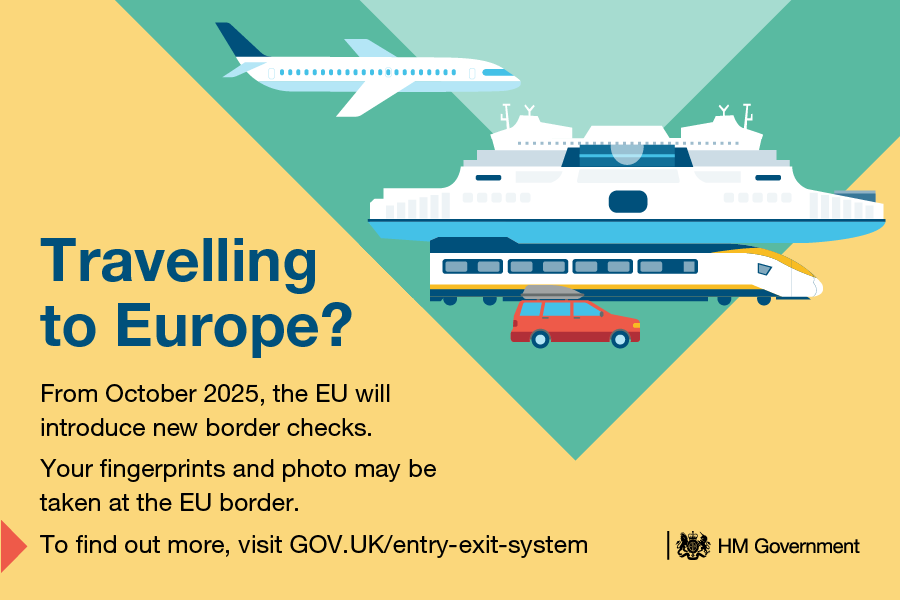EU Entry/Exit System (EES)

What is EES?
EES, or the EU Entry/Exit System, is a new digital system being introduced by the EU to strengthen its external Schengen border.
It will mean most non-EU citizens, including British citizens, will need to register their biometric details – providing fingerprints and having their photo taken – when they enter or exit the Schengen area. Travellers do not need to provide information in advance of travel – this will all be done at the border point.
This should only take a few minutes for each person to do and will eventually replace manual stamping of passports.
When is EES being introduced?
EES will be introduced from 12 October 2025. Implementation will be phased across Schengen border crossing points, (i.e. airports, seaports) over a six-month period, meaning until April 2026 you may encounter different border requirements at different ports where you enter and exit across the Schengen area.
Do I need to pay for EES?
No. There is no charge for travellers for EES registration. Any requests for payment to comply with EES are incorrect and/or fraudulent. The EU will later be introducing an advance permission to travel system, the European Travel Information and Authorisation System (ETIAS), which will require a payment. This scheme is a separate system to EES and is not expected to launch until Autumn 2026.
Where will EES registration take place?
Travellers will be required to undertake EES registration the first time they cross an external Schengen border. This will typically take place at the port or airport in their country of entry.
Passengers may be asked Schengen Border Code questions, which are basic questions about their trip. One of the most common questions that travellers are asked upon reaching the EU is whether they have a return ticket to their home country or an outward ticket to another third country once their trip in the Schengen Zone ends.
For travellers using juxtaposed controls prior to departure at the Port of Dover, Folkestone and St Pancras - French Border Control will conduct the EES registration in the UK before you board your train/ferry/shuttle. Travellers departing from St Pancras, Folkestone and the Port of Dover may also be asked if they have travel insurance, accommodation and enough funds to cover their trip.
What countries are included in the Schengen area
The countries in the Schengen area are Austria, Belgium, Bulgaria, Croatia, Czech Republic, Denmark, Estonia, Finland, France, Germany, Greece, Hungary, Iceland, Italy, Latvia, Liechtenstein, Lithuania, Luxembourg, Malta, Netherlands, Norway, Poland, Portugal, Romania, Slovakia, Slovenia, Spain, Sweden, and Switzerland.
EES is not applicable when travelling to the Republic of Ireland and Cyprus
Will I need to do this every time I travel?
Travellers will only have to create a full digital record on their first visit to the Schengen Area, or if it is more than 3 years since their last record creation.
If you return to the Schengen area within 3 years, travellers will have a faster process by only needing to update their existing digital record and provide one biometric (i.e. fingerprints or a facial image) at the point of entry and exit.
Is there anything I can do to prepare for EES?
No. Travellers will need to submit their biometric details at the Schengen border, and only once EES is introduced. It is not currently possible to register biometric details in advance of the border.
Will I be delayed?
While EES registration itself should only take around one to two minutes for each person to do, they may lead to longer wait times at Border Control upon arrival in the Schengen area. These are likely to vary from location to location and will depend on traveller volumes and processing capacity at the point at which EES processing is carried out.
At some locations, particularly the Port of Dover, Eurotunnel, and St Pancras - where French authorities operate juxtaposed immigration checks in the UK prior to departure - registration will take a few minutes per passenger, prior to leaving the UK. This may lead to longer waits at busy times.
What is the difference between EES, ETIAS and ETA?
EES (Entry/Exit System) is the EU's new digital border system that records entries and exits at the Schengen border and collects biometric data. It will in due course replace passport stamping when entering the Schengen area.
ETIAS (European Travel Information and Authorisation System) is a separate system launching in late autumn 2026 that will require pre-travel authorisation and a fee for visa exempt travellers visiting the Schengen area. ETIAS will cost €20 and be valid for multiple entries for up to three years.
ETA (Electronic Travel Authorisation) is a UK system that for inbound travellers who are non-UK citizens or residents, permitting entry to the UK for tourism, visiting family or for certain other reasons for up to 6 months. An ETA costs £16 and is valid for multiple visits for up to two years.
Frequently Asked Questions
The UK Government has created a comprehensive FAQs document which can be viewed here.

You are advised to visit gov.uk/entry-exit-system for up-to-date information

